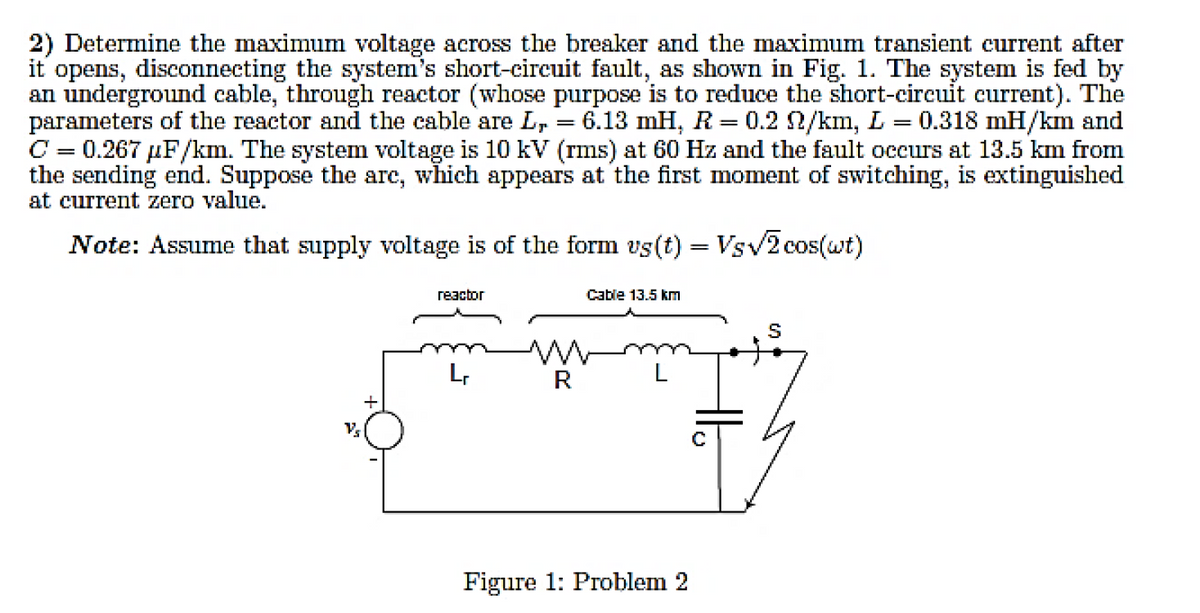2) Determine the maximum voltage across the breaker and the maximum transient current after it opens, disconnecting the system's short-circuit fault, as shown in Fig. 1. The system is fed by an underground cable, through reactor (whose purpose is to reduce the short-circuit current). The parameters of the reactor and the cable are L, = 6.13 mH, R = 0.2 2/km, L = 0.318 mH/km and C = 0.267 µF/km. The system voltage is 10 kV (rms) at 60 Hz and the fault occurs at 13.5 km from the sending end. Suppose the arc, which appears at the first moment of switching, is extinguished at current zero value. Note: Assume that supply voltage is of the form vs(t) = Vsv2 cos(wt) reactor Cable 13.5 km R
2) Determine the maximum voltage across the breaker and the maximum transient current after it opens, disconnecting the system's short-circuit fault, as shown in Fig. 1. The system is fed by an underground cable, through reactor (whose purpose is to reduce the short-circuit current). The parameters of the reactor and the cable are L, = 6.13 mH, R = 0.2 2/km, L = 0.318 mH/km and C = 0.267 µF/km. The system voltage is 10 kV (rms) at 60 Hz and the fault occurs at 13.5 km from the sending end. Suppose the arc, which appears at the first moment of switching, is extinguished at current zero value. Note: Assume that supply voltage is of the form vs(t) = Vsv2 cos(wt) reactor Cable 13.5 km R
Introductory Circuit Analysis (13th Edition)
13th Edition
ISBN:9780133923605
Author:Robert L. Boylestad
Publisher:Robert L. Boylestad
Chapter1: Introduction
Section: Chapter Questions
Problem 1P: Visit your local library (at school or home) and describe the extent to which it provides literature...
Related questions
Question
Please see attached question

Transcribed Image Text:2) Determine the maximum voltage across the breaker and the maximum transient current after
it opens, disconnecting the system's short-circuit fault, as shown in Fig. 1. The system is fed by
an underground cable, through reactor (whose purpose is to reduce the short-circuit current). The
parameters of the reactor and the cable are L,
C = 0.267 µF/km. The system voltage is 10 kV (rms) at 60 Hz and the fault occurs at 13.5 km from
the sending end. Suppose the are, which appears at the first moment of switching, is extinguished
at current zero value.
6.13 mH, R = 0.2 2/km, L = 0.318 mH/km and
%3|
Note: Assume that supply voltage is of the form vs(t) = Vsv2 cos(wt)
reactor
Cable 13.5 km
L,
R
+
Figure 1: Problem 2
Expert Solution
This question has been solved!
Explore an expertly crafted, step-by-step solution for a thorough understanding of key concepts.
This is a popular solution!
Trending now
This is a popular solution!
Step by step
Solved in 2 steps with 5 images

Knowledge Booster
Learn more about
Need a deep-dive on the concept behind this application? Look no further. Learn more about this topic, electrical-engineering and related others by exploring similar questions and additional content below.Recommended textbooks for you

Introductory Circuit Analysis (13th Edition)
Electrical Engineering
ISBN:
9780133923605
Author:
Robert L. Boylestad
Publisher:
PEARSON

Delmar's Standard Textbook Of Electricity
Electrical Engineering
ISBN:
9781337900348
Author:
Stephen L. Herman
Publisher:
Cengage Learning

Programmable Logic Controllers
Electrical Engineering
ISBN:
9780073373843
Author:
Frank D. Petruzella
Publisher:
McGraw-Hill Education

Introductory Circuit Analysis (13th Edition)
Electrical Engineering
ISBN:
9780133923605
Author:
Robert L. Boylestad
Publisher:
PEARSON

Delmar's Standard Textbook Of Electricity
Electrical Engineering
ISBN:
9781337900348
Author:
Stephen L. Herman
Publisher:
Cengage Learning

Programmable Logic Controllers
Electrical Engineering
ISBN:
9780073373843
Author:
Frank D. Petruzella
Publisher:
McGraw-Hill Education

Fundamentals of Electric Circuits
Electrical Engineering
ISBN:
9780078028229
Author:
Charles K Alexander, Matthew Sadiku
Publisher:
McGraw-Hill Education

Electric Circuits. (11th Edition)
Electrical Engineering
ISBN:
9780134746968
Author:
James W. Nilsson, Susan Riedel
Publisher:
PEARSON

Engineering Electromagnetics
Electrical Engineering
ISBN:
9780078028151
Author:
Hayt, William H. (william Hart), Jr, BUCK, John A.
Publisher:
Mcgraw-hill Education,